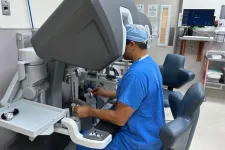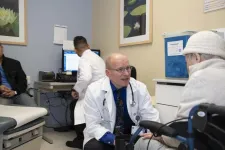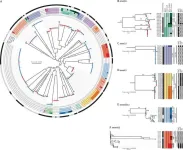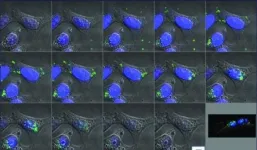(Press-News.org) New research from Memorial Sloan Kettering Cancer Center (MSK) and the Sloan Kettering Institute — a hub for basic science and translational research within MSK — identified a way to reduce toxicity in CAR T cell therapy; discovered a division of labor in DNA repair that suggests a possible therapeutic strategy for certain cancers; developed a new method to enable imaging of two PET tracers simultaneously; found biomarkers that could help predict outcomes in HER2-positive metastatic esophagogastric cancer; and made progress toward improving options for patients with early-stage, potentially indolent cancers.
Reducing neurotoxicity in CAR T cell therapy
CAR T cell therapy can sometimes cause neurotoxicity, which may include confusion, disorientation, seizures, and unconsciousness. An MSK team led by hematologic oncologist Jae Park, MD, used a drug called anakinra to reduce severe neurotoxicity in people with relapsed or refractory lymphoma treated with CAR T cells that target CD19. Anakinra works by blocking IL-1 signaling. The phase 2 clinical trial was a direct translation from research done by the laboratory of Michel Sadelain, MD, PhD, Director of MSK’s Center for Cell Engineering, which reported the effectiveness of anakinra in a mouse model in 2018 in Nature Medicine. In the new study, giving anakinra reduced severe neurotoxicity from a rate of 28%–38% usually seen with standard anti-CD19 CAR T treatment to only 9.7%. Together, all grades of neurotoxicity were reduced from 56%–64% to 19%. Dr. Park’s research team also confirmed that anakinra had made it into participants’ cerebrospinal fluid, providing evidence that the toxicity was reduced by the drug. Preventing neurotoxicity will make CAR T treatment safer, more available on an outpatient basis, and therefore more accessible to patients. in Nature Medicine.
Researchers discover division of labor in DNA repair
DNA double-strand breaks (DSBs) are an especially toxic form of DNA damage, affecting both strands of the DNA double helix. This damage can cause mutations that accumulate as cells grow and divide, fueling cancer formation and progression. Repairing DSBs is essential for any organism, and several pathways have evolved to fix these breaks with minimal changes to DNA sequence. Now the laboratory of Sloan Kettering Institute molecular biologist Agnel Sfeir, PhD, has discovered a pathway that previously was considered to be a backup pathway actually has the final say.
Microhomology-mediated end joining (MMEJ) is the only DNA repair mechanism active when cells divide during mitosis; other pathways — homologous recombination (HR) and nonhomologous end joining (NHEJ) — are suppressed. “MMEJ is not just backup, but the last-ditch repair pathway, and it comes at the expense of fidelity,” Dr. Sfeir says. “Ultimately, it’s better for cells to fix the breaks than not fix them when cells commit to cellular division.” The team, which included postdoctoral researcher and co-corresponding author Alessandra Brambati, PhD, and research technician Olivia Sacco, also found that a protein called RHINO plays a critical role in confining MMEJ during mitosis. They showed that RHINO directs another protein, polymerase theta, to DNA breaks and fixes them.
The researchers note that the division of labor in DNA repair offers a possible therapeutic strategy for certain cancers. In people with BRCA mutations, cancer cells have disabled HR repair pathways. The new findings suggest combining PARP inhibitors with drugs that disable MMEJ, including inhibitors of polymerase theta and RHINO. Unable to repair their DNA, the cancer cells would die. in Science.
New method enables imaging of two PET tracers simultaneously
Positron emission tomography (PET) is one of the most widely used diagnostic tools in cancer care. PET scans show the location of a tumor, usually based on increased glucose intake, a hallmark of cancer cells. Now research led by MSK’s Sloan Kettering Institute and collaborators at the Complutense University of Madrid have developed a new method that allows for the imaging of two different PET tracers at the same time, thereby doubling the information depth of a single PET scan. The technique, dubbed multiplexed-PET, or mPET, could reduce the number of sequential scans patients will need to receive. It also has applications in preclinical research, says MSK’s Jan Grimm, MD, PhD, co-senior author of a new study describing mPET. In mouse model experiments, the researchers used mPET to noninvasively monitor dual drug delivery, simultaneously tracking each drug. They also imaged CAR T cells, used in immunotherapy, and their target, prostate-specific membrane antigen (PSMA) tumors, in the same animals simultaneously — which has not been possible previously. “This advance could help increase the molecular information attainable during a single scan, giving scientists and radiologists alike more timely information for a diagnosis and staging that could not be done with a biopsy,” Dr. Grimm says. Study first author Edwin Pratt, PhD, adds: “The beauty is that mPET is immediately clinically translatable; the approach can be done on most existing machines, with minimal modifications.” A clinical study based on the findings is planned. in Nature Biomedical Engineering.
Biomarkers could help predict outcomes in HER2-positive metastatic esophagogastric cancer
About 20% of stomach and esophageal cancers have increased expression of the HER2 protein. For those patients, chemotherapy combined with trastuzumab (Herceptin®), an antibody that blocks HER2, has been standard treatment for more than a decade. In March 2022, the Food and Drug Administration approved the addition of a another drug to this combination: the immunotherapy pembrolizumab (Keytruda®). This approval was based on KEYNOTE 811, a multicenter clinical trial led by MSK medical oncologist Yelena Janjigian, MD, which found that this updated regimen resulted in a nearly 23% improvement in treatment response. Some people benefit more than others, however, and eventually resistance to the combination of chemotherapy, HER2 therapy, and immunotherapy treatment develops in most patients.
New research from Dr. Janjigian and MSK medical oncology Steven Maron, MD, MSc, sought to identify biomarkers that could explain this. The investigators used samples from MSK patients who participated in KEYNOTE 811. In the new study, analyses were aimed at improving the understanding of which patients will benefit most from this regimen, including circulating tumor DNA (ctDNA), whole exome sequencing, single-cell RNA sequencing, and HER2-PET scans before and during treatment. The studies revealed that amplification of the ERBB2 gene resulted in better long-term responses, while mutations in MYC and CDKN2A/B were associated with worse outcomes. The findings illustrate how liquid biopsies and HER2-PET studies can noninvasively help identify patients who will benefit the most from HER2-directed therapy and provide a more personalized treatment approach. in Clinical Cancer Research.
Moving toward better options for patients with early-stage, potentially indolent cancers
MSK has a strong history developing new approaches to minimize unnecessary treatment for specific types of cancers that may be slow-growing or not likely to progress. Epidemiologists often call these “overdiagnosed” cancers because they don’t pose a significant threat to a person’s health. MSK’s Urology Service has been a leader in promoting active surveillance for people with nonaggressive prostate cancer, and MSK’s Head and Neck Cancer Surgery and Endocrinology services have been leaders in the same approach for thyroid cancer.
New research from an MSK team led by Luc G.T. Morris, MD, MSc, a surgeon and cancer genomics researcher, has provided new insights into why some cancers remain indolent — appearing to be in a state of immune equilibrium, a phenomenon that had previously only been observed in mice. Specifically, the team analyzed tumors of the thyroid, prostate, breast, and lung, as well as melanoma — cancer types in which some tumors have been overdiagnosed.
Small and localized tumors that remain indolent were more likely to be constrained by immune surveillance, and larger tumors showed evidence of immune escape. In contrast, in more aggressive cancer types, no evidence of immune equilibrium or escape was observed. “We believe that some indolent or overdiagnosed cancers can remain in a prolonged state of immune equilibrium, but more aggressive types of cancer probably escaped from immune equilibrium at a much earlier stage, possibly even before they were clinically apparent,” Dr. Morris notes. Further validation could assist with the development of prognostic biomarkers to inform clinical decision-making and more personalized treatment options for patients with early-stage, potentially indolent cancers, he notes. in Cancer Cell.
Clinical and genomic features of response and toxicity to sotorasib in a real-world cohort of patients with advanced KRAS G12C-mutant non-small cell lung cancer
Sotorasib (Lumakras®) is a targeted therapy approved for people with non-small cell lung cancer with changes, or mutations, to the KRAS G12C gene. The drug works by halting the growth of cells that make an abnormal version of the KRAS protein. While the drug has helped many with this condition, it is unknown why some develop resistance or severe side effects to treatment.
MSK oncology/hematology fellow Rohit Thummalapalli, MD, and thoracic oncologist Kathryn C. Arbour, MD, led a retrospective study that examined medical records of 105 people with this condition who were treated with sotorasib outside of a clinical trial. Using next-generation sequencing, investigators found that people whose tumors had additional KEAP1 gene mutations experienced shorter progression-free survival and overall survival, meaning their cancer grew and spread more quickly after treatment and they died sooner, compared with those who did not have these mutations. Additionally, they discovered that people who recently received immunotherapy experienced more severe side effects than those who did not. These observations may help guide the use of sotorasib in the clinic and inform future clinical trials. in JCO Precision Oncology.
END
MSK Research Highlights July 17, 2023
2023-07-17
ELSE PRESS RELEASES FROM THIS DATE:
First robotic liver transplant in U.S. performed by Washington University surgeons
2023-07-17
A surgical team from Washington University School of Medicine in St. Louis recently performed the first robotic liver transplant in the U.S. The successful transplant, accomplished in May at Barnes-Jewish Hospital, extends to liver transplants the advantages of minimally invasive robotic surgery: a smaller incision resulting in less pain and faster recoveries, plus the precision needed to perform one of the most challenging abdominal procedures.
The patient, a man in his 60s who needed a transplant because of liver cancer and cirrhosis ...
Rice study: Men vastly outnumber women in studying legislative politics
2023-07-17
It’s no secret that men outnumber women in the halls of Congress and in other political arenas, but new research from Rice University, the University of Wisconsin-Madison and the University of Illinois Urbana-Champaign also found that significantly more men than women study the legislative process in the U.S. and abroad.
This has troubling implications for the inner workings of the discipline and the overall study of topics that impact women’s political involvement, according to Leslie Schwindt-Bayer, the Thomas Cooke and Mary Elizabeth Edwards Chair in Government and Democracy ...
City of Hope-led panel of experts updates cancer and aging guidelines issued by the American Society of Clinical Oncology
2023-07-17
LOS ANGELES — In an effort to improve treatment outcomes and quality of life for older adults with cancer, researchers from City of Hope, one of the largest cancer research and treatment organizations in the United States, and colleagues across the country today released updated guidelines by the American Society of Clinical Oncology (ASCO) outlining the need to assess and manage vulnerabilities in patients aged 65 and older prior to prescribing chemotherapy, targeted therapy and/or immunotherapy.
The updated recommendations, published in the Journal of Clinical Oncology, urges the clinical use of a validated geriatric assessment (GA) — defined as an evaluation ...
Survival of children with acute lymphatic leukemia further increased
2023-07-17
The five-year survival of all children with acute lymphatic leukemia (ALL) has continued to increase to 94%. This is evident from a study of 800 Dutch children. Within the study, modified treatment protocols for four subgroups were examined. The modifications were found to have positive effects on survival and quality of life. For example, the risk of disease recurrence became as much as three times smaller for children with an aggressive form of leukemia. Says Prof. Dr. Rob Pieters: ‘The five-year ...
Bacteria discreetly dwelling in throat revealed to be primary source of Strep A transmission
2023-07-17
Breakthrough research has found that Group A Streptococcus (GAS) infections are more likely transmitted from asymptomatic throat carriage than skin-to-skin contact in communities with high rates of infection.
This major discovery has far-reaching implications for public health approaches, vaccine development and future research as it challenges previous understanding of how the bacterium is spread.
GAS (Streptococcus pyogenes), commonly found on the skin and in the throat, can cause infections ranging from sore throats and impetigo (skin infections) to deadly bloodstream infections. In places like remote First Nations communities where the pathogen is ...
First study to directly compare gene mutation type in individuals with CHAMP1 disorder indicates key differences
2023-07-17
New research led by the Seaver Autism Center for Research and Treatment at Mount Sinai has illuminated genetic differences among children with a rare neurodevelopmental condition and could point the way toward a precision medicine approach to caring for these children.
The study is the first of its kind to directly assess differences between individuals with mutations in the CHAMP1 gene and those with deletions of the gene. The analysis was published in Human Genetics on July 17.
CHAMP1 disorder is a genetic, neurodevelopmental condition associated with intellectual disability, medical comorbidities (e.g., seizures, gastrointestinal problems), and dysmorphic ...
Innovative infection prevention program reduces surgical site infections, results in hospital days reduced and $500,000 savings
2023-07-17
Chicago — An innovative anesthesiologist-led infection prevention program helped reduce the number of surgical site infections (SSIs) in colorectal patients by 50%, the number of days in the hospital by 46%, and led to significant cost savings over a two-year period, according to research presented at the virtual American Society of Anesthesiologists’ Anesthesia Quality and Patient Safety Meeting.
“With the skyrocketing cost of medical care for patients and health care institutions, one area physicians can focus on is reducing SSIs,” ...
Shrinking light: Nanoscale optical breakthrough
2023-07-17
Imagine shrinking light down to the size of a tiny water molecule, unlocking a world of quantum possibilities. This has been a long-held dream in the realms of light science and technology. Recent advancements have brought us closer to achieving this incredible feat, as researchers from Zhejiang University have made groundbreaking progress in confining light to subnanometer scales.
Traditionally, there have been two approaches to localize light beyond its typical diffraction limit: dielectric confinement and plasmonic confinement. However, challenges such as precision fabrication and optical loss have hindered the confinement of optical fields to sub-10 nanometer (nm) or even ...
UMD researchers uncover privacy risks in cellphones purchased at police auctions
2023-07-17
Law enforcement agencies nationwide regularly sell items that are seized in criminal investigations or are unclaimed from lost-and-found inventories. Many of these items—vehicles, jewelry, watches and electronic devices like cellphones—end up at online auction houses.
People looking for a bargain can bid on cellphones in bulk, snatching up dozens at rock bottom prices for parts or other uses. This ultimately provides revenue for the police agencies, making for a good deal for everyone involved. Or is it?
A recent study by University of Maryland security experts found that many of the phones sold ...
Bacterial protein found in the urogenital tract may contribute to reduced fertility, birth defects
2023-07-17
A team of researchers from the University of Maryland School of Maryland’s (UMSOM) Institute of Human Virology (IHV), a Center of Excellence of the Global Virus Network (GVN), published new findings that emphasize the crucial role of the urinary and genital tract microbiota in adverse pregnancy outcomes and genomic instability that originate in the womb during fetal development.
The study, published on July 17 in the Proceedings of the National Academy of Sciences of the United States of America (PNAS), established a new link between genomic instability and a protein from Mycoplasma fermentans, a kind of bacterium that commonly ...






